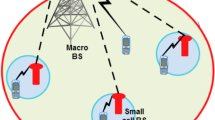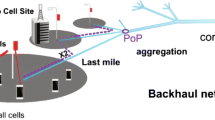Abstract
An innovative architecture employing wireless backhaul in hierarchical wireless networks is considered in this paper to provide high throughput densities. Multi-beam antennas, combined with aggressive frequency reuse have recently been exploited to increase the throughput density in densely deployed wireless networks. However, large number of narrow beams cause not only co-channel interference but also inter-cell interference. To mitigate this problem, amplitude tapering in multi-beam antennas is investigated in this paper. Results show that tapered beams significantly improve the carrier to interference ratio from 5 to 8 dB and consequently achieve downlink throughput density over 0.65 Gbps/km\(^2\). An overall throughput density of 1.2 Gbps/km\(^2\) is expected when taking both up- and downlinks into account.











Similar content being viewed by others
References
Marinchenco, O. et al. (2011). BuNGee project overview. IEEE International Conference on Microwaves, Communications, Antennas and Electronics Systems (COMCAS).
Khan, N., & Oestges, C. (2011). Impact of transmit antenna beamwidth for fixed relay links using ray-tracing and WINNER II channel models. In Proceedings of the 5th European conference on antennas and propagation (pp. 2938–2941). Rome.
Cardieri, P., & Rappaport, T. (Mar 2001). Application of narrow-beam antennas and fractional loading factor in cellular communication systems. IEEE Transactions on Vehicular Technology, 50(2), 430–440.
Czylwik, A., & Dekorsy, A. (2004). System-level performance of antenna arrays in cdma-based cellular mobile radio systems. EURASIP Journal on Advances in Signal Processing, 2004(9), 703278.
Qin-Min, W., Zhong-Pei, Z., Hui, Y., & Feng-Ke, J. (2010). Interference performance analysis in comp for downlink system. In Communications and Networking in China (CHINACOM), 2010 5th International ICST Conference on (pp. 1–5).
Khan, N., Jiang, T., Grace, D., Burr, A. G., & Oestges, C. (2012). Impact of multi-beam antenna amplitude tapering on co-channel interference and backhaul throughput density. In The 15th Wireless personal multimedia communications symposium (WPMC’12). Taiwan: Taipei.
Mani, F. (2012). Improved ray-tracing for advanced radio propagation channel modeling. PhD Thesis, ICTEAM, UCL Belgium.
Vitucci, E. M. et al. (2012). Analysis and modeling of the polarimetric properties of scattering from building walls. IEEE Transactions on Antennas and Propagation.
Mani, F., & Oestges, C. (2011). Ray-tracing evaluation of diffuse scattering in an outdoor scenario. In 5th European conference on antennas and propagation, EuCAP 11, Rome.
Oestges, C., Clerckx, B., Raynaud, L., & Vanhoenacker-Janvier, D. (2002). Deterministic channel modeling and performance simulation of microcellular wide-band communication systems. IEEE Transactions on Vehicular Technology, 51(6), 1422–1430.
Degli-Esposti, V., Fuschini, F., Vitucci, E., & Falciasecca, G. (2009). Speed-up techniques for ray tracing field prediction models. IEEE Transactions on Antennas and Propagation, 57(5), 1469–1480.
Antennas, C. (2012). Beyond next generation mobile broadband: BuNGee. Microwave Journal. Online: http://www.microwavejournal.com/articles/456-beyond-next-generation-mobile-broadband-bungee.
Seidel, S., & Rappaport, T. (1994). Site-specific propagation prediction for wireless in-building personal communication system design. IEEE Transactions on Vehicular Technology, 43(4), 879–891.
Athanasiadou, G., Nix, A., & McGeehan, J. (2000). A microcellular ray-tracing propagation model and evaluation of its narrow-band and wide-band predictions. IEEE Journal on Selected Areas in Communications, 18(3), 322–335.
Athanasiadou, G., & Nix, A. (2000). Investigation into the sensitivity of the power predictions of a microcellular ray tracing propagation model. IEEE Transactions on Vehicular Technology, 49(4), 1140–1151.
Landmann, M., Sivasondhivat, K., Takada, J.-I., Ida, I., & Thoma, R. (2007). Polarization behavior of discrete multipath and diffuse scattering in urban environments at 4.5 GHz. EURASIP Journal on Wireless Communications and Networking, 2007(1), 057980.
Salmi, J., Poutanen, J., Haneda, K., Richter, A., Kolmonen, V.-M., Vainikainen, P., & Molisch, A. F. (2010). Incorporating diffuse scattering in geometry-based stochastic MIMO channel models. In Proceedings of the 4th European conference on antennas and propagation (EuCAP’10) (pp. 1–5).
Degli-Esposti, V., Fuschini, F., Vitucci, E. M., & Falciasecca, G. (2007). Measurement and modelling of scattering from buildings. IEEE Transactions on Antennas and Propagation, 55(1), 143–153.
Kowalczyk, Z. et al. (2011). Functional bungee specs, economic model, energy efficiency and frequency bands, FP7 BuNGee project D1.1. http://www.ict-bungee.eu/2012.
Kyosti, P. et al. (2007). WINNER II channel models. European Commission, Deliverable IST-WINNER D1.1.2 ver 1.1. http://projects.celticinitiative.org/winner+/WINNER2-Deliverables/.
Jiang, T. et al. (2012). Simulation tool(s) and simulation results. FP7 BuNGee project D4.1.2. http://www.ict-bungee.eu/2012.
Acknowledgments
The article presents the joint work performed by the partners in the BuNGee consortium (FP7/2007-2013), funded under Grant Agreement No. 248267. The authors would also like to acknowledge the framework of PAI P7/23 BESTCOM project for supporting this work. It was also carried out in cooperation within the European COST IC1004 action. Further, the authors are grateful to Cobham Antennas for providing the measured antenna data used in the ray-tracing tool.
Author information
Authors and Affiliations
Corresponding author
Rights and permissions
About this article
Cite this article
Khan, N., Jiang, T., Grace, D. et al. Performance Evaluation of Interference Bound Backhaul Links in High Capacity Wireless Networks. Wireless Pers Commun 74, 1129–1145 (2014). https://doi.org/10.1007/s11277-013-1568-z
Published:
Issue Date:
DOI: https://doi.org/10.1007/s11277-013-1568-z




